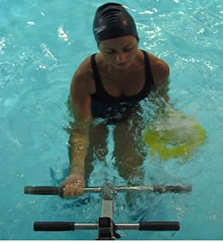Water gymnastics is a type of physical activity that became fashionable in the 1980s and, since then, has been continuously gaining public. In general terms, its practice consists of a continuous body activity in an aquatic environment. And this is the differential of hydrogymnastics: the use of the aquatic environment to give resistance to movements, making the exercises more effective, as well as to protect the joints from the impacts that would be caused by the same exercises if they were performed in another environment.
A water aerobics class is usually done in swimming pools (but nothing prevents it from being held in lakes or in the sea), so that the water reaches up to the practitioner's shoulder. This is important for two reasons: the first is that water at this height allows for greater efficiency in localized exercises for the upper limbs; the second is that it allows people to stay well supported on their feet in the pool, an ideal position for not damage the lumbar spine, while also allowing access to practice for people who do not know swim.
All classes begin with a warm-up of the muscles and an elevation of the heart rate. It's important to say that this part can also include stretching. However, it is the second part of the class (also called the main part) that constitutes the essential body of practice: here the objective to be specifically worked. achieved, which can be increased cardiorespiratory capacity, if the activity is performed at moderate intensity and uninterrupted, or muscle strengthening located. For the parts of the body to be exercised locally, it is very common to use equipment to increase the resistance that water provides to movement. At the end of the class, a relaxation activity is needed to return the heartbeat to its initial state, and it is very common for stretching activities to be associated with a return to calm. This last part of the class takes no more than ten minutes if we think of a standard class fifty minutes long.
Do not stop now... There's more after the advertising ;)
You don't need any special clothing to do water aerobics: a bathing suit or sunkini and the use of a cap are more than enough. Some people like to wear non-slip socks to keep them from slipping when they come in contact with the bottom of the pool. However, its use is not fundamental for practice.
The benefits of hydrogymnastics are many because they include all those physical activities on land (aerobic or localized), allied to the almost non-existent impact on the joints. That is why there is a belief that water aerobics is a type of physical activity aimed at the elderly: usually, it is the elderly who suffer from pain joints or even with osteoporosis, which would prevent them from doing any type of physical activity with a significant impact on the joints. The hydrogymnastics then presents itself as a great possibility of practice, not only for the elderly, but for all people.
By Paula Rondinelli
Brazil School Collaborator
Graduated in Physical Education from the São Paulo State University “Júlio de Mesquita Filho” – UNESP
Master in Motricity Sciences from the São Paulo State University “Júlio de Mesquita Filho” – UNESP
Doctoral Student in Integration of Latin America at the University of São Paulo - USP
Sport - PE - Brazil School
Would you like to reference this text in a school or academic work? Look:
RONDINELLI, Paula. "Hydrogymnastics"; Brazil School. Available in: https://brasilescola.uol.com.br/educacao-fisica/hidroginastica.htm. Accessed on June 29, 2021.
PE

Water Bike, a new modality practiced in water, a modality that mixes several hydrogymnastic techniques with different equipment, aquatic ergometer, ideal modality for people who want to improve their quality of life, modality for who doesn't you

